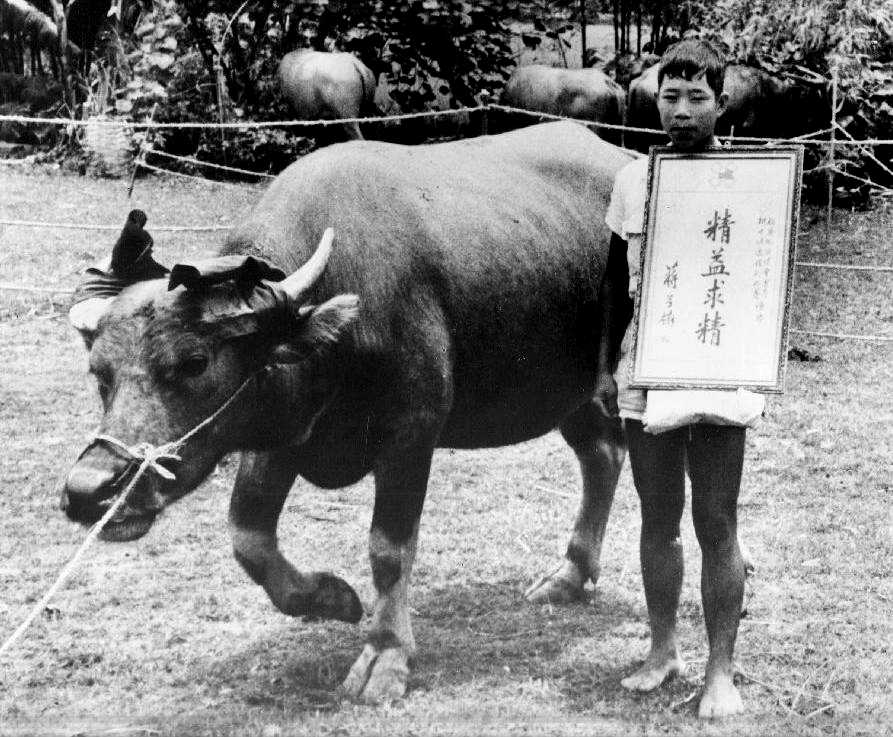
Taiwan Economy: Nationalist Control and Refuge (1945-49)

Figure 1.--The Taiwan economy was still largely agricukltural with at the end of the Pacific War the Japanese handed the island over to the Nationzalists. Many farmer did not own the land they worked. The United States became involved in Taiwan after the Chinese intervened in the Korean War (1950). American aid was one factor in the subsequent rapid growth is the islands. A land reform program helped many farmers purchase land. The caption of this press photo read, "Sign of a champiopn: Proudly displaying hos winning certificate, a Formosan youth standsc next to his champion water buffalo, which walked off with a first-place prize in a contest sponsored by the Joint Chinese American Commision on Rural Reconstruction. The youngster, a member of a group similar to the 4-H Club, allowed the buffalo to show he's a champ by letting him wear thec red ribbon around his horns.
|
|
The Japanese after the Pacific War were required to return Taiwan to China and repatriate Japanese nationals. The Taiwan population was not consulted on their future. The Japanese turned over control to Nationalist troops. Damage to Taiwan's infrastructure was limited during the War. American air strikes had focused on military targets. And there was very limited industry on the island. The island was, however, affected by the war. The economy was tied into the Japanese economy and thus had to reajust. The Nationalists gave little attention to the island after taking control. The major action was to confiscate the property of the Japanese natiinals who were expelled and shipped basck to the Home Islands. The Nationalists formed Several large public corporations. At first, only limited numbers of Chinese moved to the island. Taiwan uunder Nationalist control experienced some violence and hyperinflation. The situation on Taiwan changed with the Communist victory on the Mainland (1948-49). Aftr losing the Chinese Civil War, Chiang Kai-check and the Nationalists retreated to Taiwan. Nationlist soldiers and refugees flooded onto the island. In ainle year, the popuilation increased an estimated 20 percent. The Chinese Communists did not have the naval and air capability to bridge the Taiwan Straits with awell armed force defending the island. Most of the ethnic Chinese from the Mainland settle in the cities. It was from this group that the Nationalist Government and public sector was formed. Most of the economy was still agricultural and dominated by the indigernous Taiwan population, but was still recovering from the loss of Japanese markets and now trade with China was no longer possible.
HBC

Navigate the Boys' Historical Clothing Web Site:
[Return to the Asian Taiwan economic pages]
[Return to the Asian country economic pages]
[Introduction]
[Activities]
[Biographies]
[Chronology]
[Cloth and textiles]
[Clothing styles]
[Countries]
[Topics]
[Bibliographies]
[Contributions]
[FAQs]
[Glossaries]
[Images]
[Links]
[Registration]
[Tools]
[Boys' Clothing Home]
Navigate the Boys' Historical Clothing national pages:
[Return to the Main Taiwan page]
[Return to the Main Asian page]
[Afghanistan]
[Bangladash]
[Bhutan]
[China]
[India]
[Pakistan]
[Sri Lanka]
[Tajikistan]
[Turkmenistan]
[Uzbeckistan]
Created: 7:42 AM 8/18/20111
Last updated: 7:42 AM 8/18/2011



